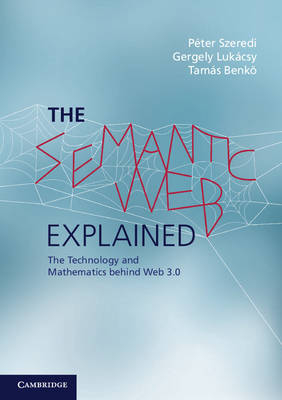
The Semantic Web Explained
Cambridge University Press (Verlag)
978-0-521-70036-8 (ISBN)
The Semantic Web is a new area of research and development in the field of computer science that aims to make it easier for computers to process the huge amount of information on the web, and indeed other large databases, by enabling them not only to read, but also to understand the information. Based on successful courses taught by the authors, and liberally sprinkled with examples and exercises, this comprehensive textbook describes not only the theoretical issues underlying the Semantic Web, but also algorithms, optimisation ideas and implementation details. The book will therefore be valuable to practitioners as well as students, indeed to anyone who is interested in Internet technology, knowledge engineering or description logics. Supplementary materials available online include the source code of program examples and solutions to selected exercises.
Péter Szeredi is an Associate Professor at the Budapest University of Technology and Economics (BUTE). In the mid-1970s he authored the first Hungarian Prolog interpreter and led the development of the MProlog system, a pioneering Hungarian software product sold worldwide in the 1980s. His main fields of interest include declarative programming (logic programming, constraint programming, the Prolog language); semantic technologies (Semantic Web, semantic integration); exploiting parallelism and programming languages supporting parallelism; as well as implementation of programming languages. He is the author and co-author of about 90 peer-reviewed publications, including 14 books/book chapters and eight journal publications. In recognition of his pioneering work in the field, he was honoured by the Association of Logic Programming as one of the fifteen Founders of Logic Programming. Gergely Lukácsy is a Senior Software Engineer at Cisco Systems, Ireland. He received his PhD in Computer Science from the Budapest University of Technology, Hungary, in June 2008. The main contribution in his PhD dissertation was a novel description logic reasoning approach that works effectively in cases of huge amounts of data. This result is particularly important for the Semantic Web area, where it is essential to have systems that can reason efficiently over large data sets. Lukácsy has published more than 25 articles in journals, books, refereed conferences and workshops. He has been working on various research projects involving semantic technologies and logic programming since 2000. His main results include the DLog reasoner which uses logic programming techniques for efficient reasoning, including program analysis and transformation techniques and parallelisation. He has also been involved in the design and development of logic-based information integration systems that use knowledge representation, constraint logic programming and reasoning techniques. Tamás Benkő is a Research Associate at the Digital Enterprise Research Institute, Ireland. He is involved in the development of the Semantic Web indexing project Sindice. His main fields of interest include declarative programming (logic programming, constraint programming, the Prolog language); semantic technologies (Semantic Web, semantic integration). He is the author and co-author of several related conference papers and books.
Introduction; Part I. The Semantic Web: 1. The World Wide Web today; 2. The Semantic Web and the RDF language; 3. Managing and querying RDF sources; Part II. Ontologies and Logics: 4. Description logics; 5. Reasoning on simple description logics; 6. Implementing a simple description logic reasoning engine; 7. The SHIQ tableau algorithm; Part III. Ontologies and the Semantic Web: 8. The Web Ontology Language; References; Index.
| Erscheint lt. Verlag | 11.9.2014 |
|---|---|
| Co-Autor | Zsolt Nagy |
| Zusatzinfo | Worked examples or Exercises; 2 Halftones, unspecified; 115 Line drawings, unspecified |
| Verlagsort | Cambridge |
| Sprache | englisch |
| Maße | 174 x 247 mm |
| Gewicht | 830 g |
| Themenwelt | Mathematik / Informatik ► Informatik ► Datenbanken |
| Informatik ► Software Entwicklung ► SOA / Web Services | |
| Mathematik / Informatik ► Informatik ► Web / Internet | |
| ISBN-10 | 0-521-70036-1 / 0521700361 |
| ISBN-13 | 978-0-521-70036-8 / 9780521700368 |
| Zustand | Neuware |
| Haben Sie eine Frage zum Produkt? |
aus dem Bereich


